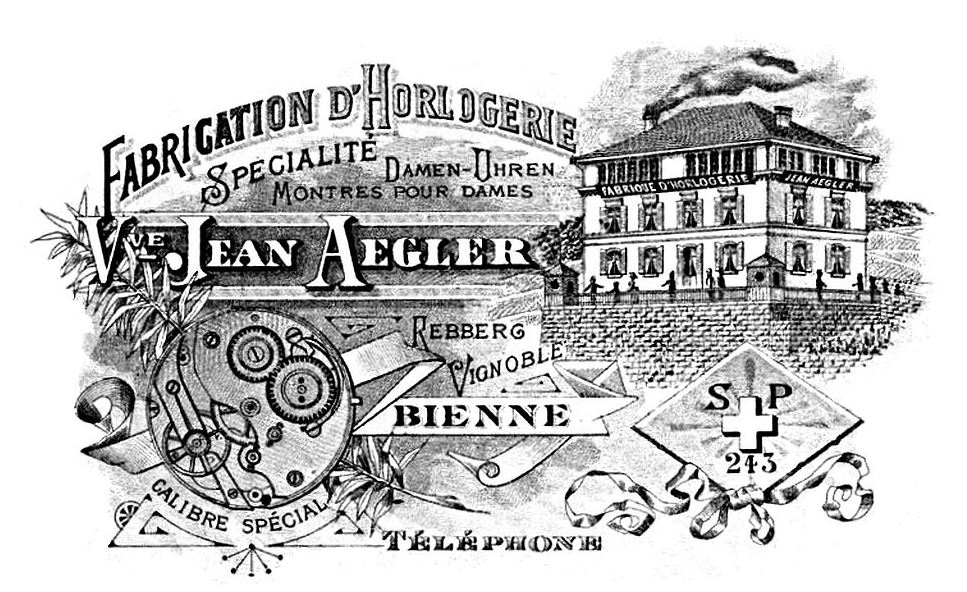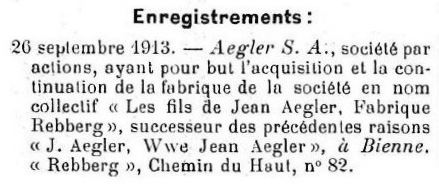Aegler SA was a maker of watch movements based in Bienne/Biel, Switzerland. It was renamed Manufacture de Montres Rolex SA and was the primary supplier of movements for Rolex for decades until being purchased in 2004.
Jean Aegler
Jean Aegler was born on 25 January 1850 in Krattigen, a small Swiss village about 90 kilometres southeast of Biel/Bienne. Aegler trained as a watchmaker and opened a watchmaking factory in Bienne in 1878, with his father Johannes Aegler. Jean’s father was a school teacher, so it is unlikely that he ever took an active part in the watchmaking business. Initially, it is most likely that Jean started out either assembling or finishing component parts for other companies until he had acquired the machinery and capability to produce the complete movements.
By 1886 the firm was specialising in small watch movements, including pendant watches for ladies and remontoirs (keyless watches). The firm received one of the first Swiss patents, number 243, for a keyless stem winding and setting mechanism. Jean Aegler died on 2 August 1891 in Bienne at the relatively young age of 41 years. Jean’s widow, Anna Maria took over the firm, which became known as Veuve Jean Aegler (widow of Jean Aegler), often abbreviated to Vve. Jean Aegler. Anna Maria relocated the factory to Rue du Vignoble in the Rebberg/Vignoble hills above Bienne. The company began to advertise its location as being at the “Rebberg” factory. Eventually, Rebberg became a brand in the Aegler watch range.

Aegler movements
Veuve Jean Aegler was different from most other movement manufacturers of the time for two main reasons. First of all, they focussed on high-quality lever movements. These were more robust and precise than the more common cylinder escapements found in less expensive watches. Additionally, Aegler specialised in women’s watch movements, as the advertisement above shows (“Montres pour Dames” in French, “Damen-Uhren” in German). Traditionally, men’s watches were generally large pocket watches. Women, on the other hand, would either carry small pocket watches or wear them on the wrist or pinned to their clothing. As the women’s watches were smaller, their movements had to be as well. The reduced size made them more complex to produce. The combination of both the high quality and small sizes of the Aegler movements caught the attention of a very ambitious young man named Hans Wilsdorf, who would go on to found the firm Wilsdorf & Davis, which would later be known as Rolex.
Wilsdorf was a visionary, he believed that the future of the watchmaking industry lay in the production of wristwatches rather than the traditional pocket watch. The unique characteristics of the Aegler movements were perfect for Wildorf’s vision. In 1905, Aegler began working with Wilsdorf & Davis, supplying the London-based watch company with movements. In 1906, the firm became known as Les Fils de Jean Aegler, as Jean’s son Hermann Aegler took over. Over the years Hermann built a strong working relationship with Hans Wilsdorf. After the firm began branding its watches “Rolex” in 1908, Hans Wilsdorf asked Aegler to increase production for his firm. Aegler SA continued producing its own watches under the Rebberg and Final brands, focusing on ladies’ models. Aegler became a limited company on the 20th of September 1913 as per the document below. The company was reorganized on July 30, 1914, becoming Aegler SA, Rolex Watch Co.
Rolex
Wilsdorf & Davis was renamed Rolex Watch Co. Ltd in 1915. They relocated from London to Geneva in 1919. Since it was exclusively supplying movements to them, Rolex took an ownership stake in the Aegler factory. In turn, the Aegler family acquired shares in Rolex and received a seat on the board. Although still owned primarily by the Aegler family, the factory complex in Bienne erected a famous sign, “ROLEX”, along with the company’s signature crown on the roof. The company became known as Manufacture de Montres Rolex.
Aegler SA produced the famous Perpetual movement, invented by Aegler employee Emile Borer. Other famous Rolex products of the Aegler factory include the Datejust and Day-Date movements, and the Parachrom hairspring material. In 2004, Rolex ultimately acquired Aegler.
Related content
Aegler at Watch Wiki
